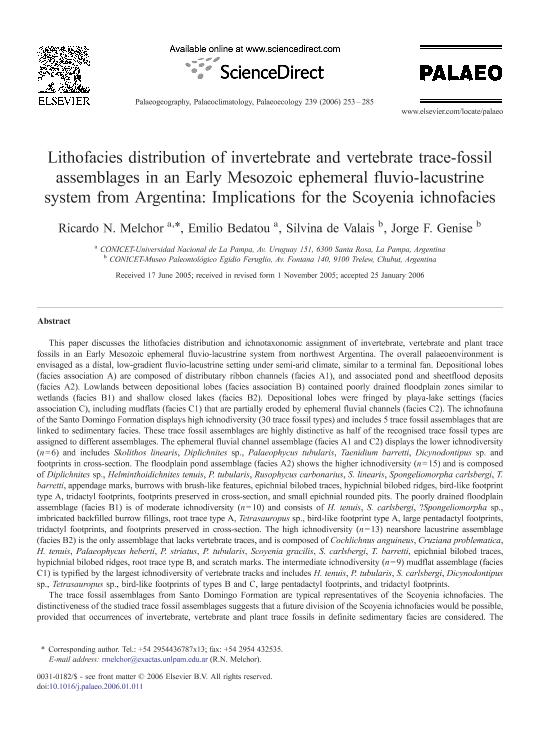Mostrar el registro sencillo del ítem
dc.contributor.author
Melchor, Ricardo Nestor

dc.contributor.author
Bedatou, Emilio

dc.contributor.author
de Valais, Silvina

dc.contributor.author
Genise, Jorge Fernando

dc.date.available
2019-08-20T18:31:50Z
dc.date.issued
2006-09
dc.identifier.citation
Melchor, Ricardo Nestor; Bedatou, Emilio; de Valais, Silvina; Genise, Jorge Fernando; Lithofacies distribution of invertebrate and vertebrate trace-fossil assemblages in an Early Mesozoic ephemeral fluvio-lacustrine system from Argentina: Implications for the Scoyenia ichnofacies; Elsevier Science; Palaeogeography, Palaeoclimatology, Palaeoecology; 239; 3-4; 9-2006; 253-285
dc.identifier.issn
0031-0182
dc.identifier.uri
http://hdl.handle.net/11336/81829
dc.description.abstract
This paper discusses the lithofacies distribution and ichnotaxonomic assignment of invertebrate, vertebrate and plant trace fossils in an Early Mesozoic ephemeral fluvio-lacustrine system from northwest Argentina. The overall palaeoenvironment is envisaged as a distal, low-gradient fluvio-lacustrine setting under semi-arid climate, similar to a terminal fan. Depositional lobes (facies association A) are composed of distributary ribbon channels (facies A1), and associated pond and sheetflood deposits (facies A2). Lowlands between depositional lobes (facies association B) contained poorly drained floodplain zones similar to wetlands (facies B1) and shallow closed lakes (facies B2). Depositional lobes were fringed by playa-lake settings (facies association C), including mudflats (facies C1) that are partially eroded by ephemeral fluvial channels (facies C2). The ichnofauna of the Santo Domingo Formation displays high ichnodiversity (30 trace fossil types) and includes 5 trace fossil assemblages that are linked to sedimentary facies. These trace fossil assemblages are highly distinctive as half of the recognised trace fossil types are assigned to different assemblages. The ephemeral fluvial channel assemblage (facies A1 and C2) displays the lower ichnodiversity (n = 6) and includes Skolithos linearis, Diplichnites sp., Palaeophycus tubularis, Taenidium barretti, Dicynodontipus sp. and footprints in cross-section. The floodplain pond assemblage (facies A2) shows the higher ichnodiversity (n = 15) and is composed of Diplichnites sp., Helminthoidichnites tenuis, P. tubularis, Rusophycus carbonarius, S. linearis, Spongeliomorpha carlsbergi, T. barretti, appendage marks, burrows with brush-like features, epichnial bilobed traces, hypichnial bilobed ridges, bird-like footprint type A, tridactyl footprints, footprints preserved in cross-section, and small epichnial rounded pits. The poorly drained floodplain assemblage (facies B1) is of moderate ichnodiversity (n = 10) and consists of H. tenuis, S. carlsbergi, ?Spongeliomorpha sp., imbricated backfilled burrow fillings, root trace type A, Tetrasauropus sp., bird-like footprint type A, large pentadactyl footprints, tridactyl footprints, and footprints preserved in cross-section. The high ichnodiversity (n = 13) nearshore lacustrine assemblage (facies B2) is the only assemblage that lacks vertebrate traces, and is composed of Cochlichnus anguineus, Cruziana problematica, H. tenuis, Palaeophycus heberti, P. striatus, P. tubularis, Scoyenia gracilis, S. carlsbergi, T. barretti, epichnial bilobed traces, hypichnial bilobed ridges, root trace type B, and scratch marks. The intermediate ichnodiversity (n = 9) mudflat assemblage (facies C1) is typified by the largest ichnodiversity of vertebrate tracks and includes H. tenuis, P. tubularis, S. carlsbergi, Dicynodontipus sp., Tetrasauropus sp., bird-like footprints of types B and C, large pentadactyl footprints, and tridactyl footprints. The trace fossil assemblages from Santo Domingo Formation are typical representatives of the Scoyenia ichnofacies. The distinctiveness of the studied trace fossil assemblages suggests that a future division of the Scoyenia ichnofacies would be possible, provided that occurrences of invertebrate, vertebrate and plant trace fossils in definite sedimentary facies are considered. The subdivision of the Scoyenia ichnofacies into recurrent groups of trace fossils (ichnosubfacies) with a palaeoecological and palaeoenvironmental meaning can be based on two approaches: distinction of associations of vertebrate tracks and recognition of ichnocoenoses related to substrates with different degrees of water saturation and firmness. The first approach can be based on an evaluation of the recurrent vertebrate ichnoceonoses used to recognise vertebrate ichnofacies. In this way, some of the candidate vertebrate ichnofacies are proposed as subdivisions of the Scoyenia ichnofacies. The second approach is based on the identification of crosscutting relationships between trace fossils and between trace fossils and sedimentary structures within some trace fossil assemblages. Using this methodology, it is possible to define distinct assemblages of trace fossils: a "pre-desiccation suite" with structures lacking ornamentation and developed in a soft substrate and a "desiccation suite" typified by striated traces that crosscut the former. These trace-fossil assemblages help to characterise the changes in organism-sediment interaction during progressive desiccation of a water-lain substrate. Additional neoichnological studies are necessary to assess the exact meaning of different trace fossil features in terms of substrate consistency.
dc.format
application/pdf
dc.language.iso
eng
dc.publisher
Elsevier Science

dc.rights
info:eu-repo/semantics/openAccess
dc.rights.uri
https://creativecommons.org/licenses/by-nc-sa/2.5/ar/
dc.subject
Continental Ichnofacies
dc.subject
Ephemeral Channels
dc.subject
Invertebrate Trace Fossils
dc.subject
Playa-Lake
dc.subject
Root Traces
dc.subject
Scoyenia Ichnofacies
dc.subject
Shallow Lacustrine
dc.subject
Vertebrate Footprints
dc.subject.classification
Paleontología

dc.subject.classification
Ciencias de la Tierra y relacionadas con el Medio Ambiente

dc.subject.classification
CIENCIAS NATURALES Y EXACTAS

dc.title
Lithofacies distribution of invertebrate and vertebrate trace-fossil assemblages in an Early Mesozoic ephemeral fluvio-lacustrine system from Argentina: Implications for the Scoyenia ichnofacies
dc.type
info:eu-repo/semantics/article
dc.type
info:ar-repo/semantics/artículo
dc.type
info:eu-repo/semantics/publishedVersion
dc.date.updated
2019-08-16T13:24:50Z
dc.journal.volume
239
dc.journal.number
3-4
dc.journal.pagination
253-285
dc.journal.pais
Países Bajos

dc.journal.ciudad
Amsterdam
dc.description.fil
Fil: Melchor, Ricardo Nestor. Consejo Nacional de Investigaciones Científicas y Técnicas. Instituto de Ciencias de la Tierra y Ambientales de La Pampa. Universidad Nacional de La Pampa. Facultad de Ciencias Exactas y Naturales. Instituto de Ciencias de la Tierra y Ambientales de La Pampa; Argentina
dc.description.fil
Fil: Bedatou, Emilio. Consejo Nacional de Investigaciones Científicas y Técnicas. Instituto de Ciencias de la Tierra y Ambientales de La Pampa. Universidad Nacional de La Pampa. Facultad de Ciencias Exactas y Naturales. Instituto de Ciencias de la Tierra y Ambientales de La Pampa; Argentina
dc.description.fil
Fil: de Valais, Silvina. Consejo Nacional de Investigaciones Científicas y Técnicas; Argentina. Museo Paleontológico Egidio Feruglio; Argentina
dc.description.fil
Fil: Genise, Jorge Fernando. Consejo Nacional de Investigaciones Científicas y Técnicas; Argentina. Museo Paleontológico Egidio Feruglio; Argentina
dc.journal.title
Palaeogeography, Palaeoclimatology, Palaeoecology

dc.relation.alternativeid
info:eu-repo/semantics/altIdentifier/url/https://www.sciencedirect.com/science/article/pii/S0031018206000563
dc.relation.alternativeid
info:eu-repo/semantics/altIdentifier/doi/https://doi.org/10.1016/j.palaeo.2006.01.011
Archivos asociados
